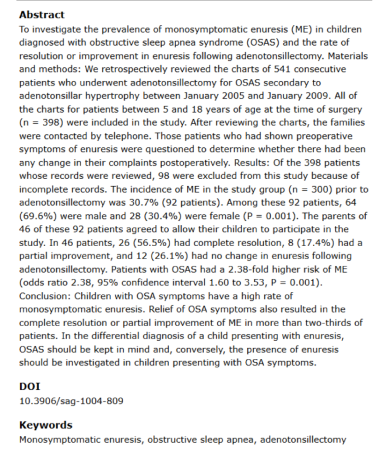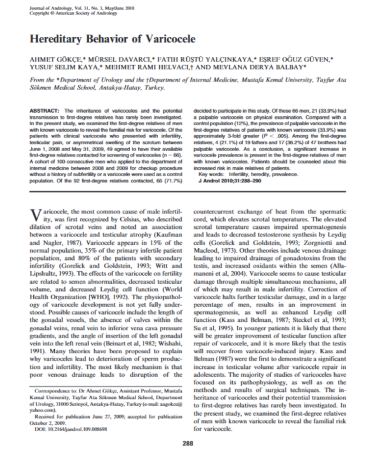Had
Abstract To investigate the prevalence of monosymptomatic enuresis (ME) in children diagnosed with obstructive sleep apnea syndrome (OSAS) and the rate of resolution or improvement in enuresis following adenotonsillectomy. Materials and methods: We retrospectively reviewed the charts of 541 consecutive patients who underwent adenotonsillectomy for OSAS secondary to adenotonsillar hypertrophy between January 2005 and January 2009. All of the charts for patients between 5 and 18 years of age at the time of surgery (n = 398) were included in the study. After reviewing the charts, the families were contacted by telephone. Those patients who had shown preoperative symptoms of enuresis were questioned to determine whether there had been any change in their complaints postoperatively. Results: Of the 398 patients whose records were reviewed, 98 were excluded from this study because of incomplete records. The incidence of ME in the study group (n = 300) prior to adenotonsillectomy was 30.7% (
Abstract Summary: This study investigates the familial risk of varicocele by examining the first-degree relatives of men with known varicoceles. Among 49 men with clinical varicocele who presented with infertility, testicular pain, or scrotal swelling between June 2008 and May 2009, 66 first-degree relatives were screened. Compared to a control group of 100 men without varicocele, the prevalence of palpable varicocele in first-degree relatives (33.9%) was significantly higher (3 times) than in the control group (12%). Fathers (21.1%) and brothers (36.2%) of patients with varicocele showed the highest prevalence. The study suggests a hereditary aspect of varicocele and recommends counseling for male relatives of affected individuals regarding the increased risk. This study highlights the need for further research into the genetic causes and clinical impact of varicocele inheritance.

